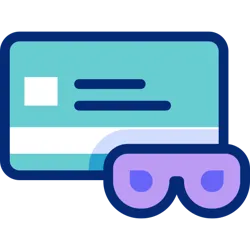Fraud and fraud detection impacts hundreds of thousands of individuals and businesses in the United States annually. It is less an unfortunate byproduct of our current financial ecosystem than a simple certainty that all business owners will have to deal with sooner or later. All you can hope to do is be prepared to mitigate the risk of fraud when it does arise.
Credit card fraud is the most commonplace form of fraud in America, with more than 440,000 cases reported annually. This categorization extends to bank fraud, tax fraud, identity fraud, and a range of other sub-varieties, all of which can result in severe losses for victims.[1]The Ascent, A Motley Fool Service. “Identity Theft and Credit Card Fraud Statistics for 2023.” Accessed on October 7, 2024. While there is no way to eliminate the possibility of fraud entirely, fraud detection can help business owners identify and respond to potential threats before they result in actionable losses.
There are many forms of fraud, including welfare fraud and friendly fraud. Modern fraud detection is ever-evolving, incorporating various strategies and software programs. Through tools such as machine learning and automated fraud software, businesses can now track suspicious activity online and in person.
What does implementing robust credit card fraud detection do for your business? Simply put, it safeguards your practice by pinpointing and preventing fraudulent transactions. This emphasis on security preserves the trust of your customer base and ensures a safe payment environment overall.
In this guide, we’ll explore credit card fraud detection in detail. We’ll discuss why it’s important, how it works, and how to spot the most common forms of fraud. Read on to learn more!
What is Fraud Detection?
Fraud detection involves identifying financial crimes in which the criminals seek to harm your business fiscally or in terms of reputation. In most cases, fraud detection can be categorized as payment fraud detection, i.e., spotting suspicious payments before finalizing a transaction. These payments can be made online or through a credit or debit card.

Since fraud negatively affects so many consumers, the tools put in place to combat it must be highly effective. Modern fraud detection encompasses an array of technological tools, including behavioral analysis and real-time monitoring. The goal is to assess transaction patterns regarding what is or is not regular. When there are deviations from the norm, these tools will flag said deviations and alert the consumer of any unusual activity.
What are the factors taken into account by fraud detection tools? IP addresses, consumer behavior, and geographical locations, to name just a few. In recent years, a series of third-party software providers have entered the fraud prevention sector to shield business owners from scammers and other financial criminals.
Why is Fraud Detection Important?
Below, we’ll explain a few of the reasons why fraud detection should be an integral priority for your business moving forward:

Reduce financial losses
On some core level, people need fraud prevention tools because they don’t want to be cheated out of money by unscrupulous third parties. Businesses bereft of fraud prevention resources may find themselves vulnerable to chargeback fraud, return fraud, account takeover fraud, and losses resulting from stolen credit cards. Failing to utilize fraud detection to your business’s advantage can severely damage your profit margins, as it’s estimated that businesses worldwide lose an average of 5% of their earnings to fraud each year.[2]ACFE. “ACFE Report Estimates Organizations Worldwide Lose 5% of Revenues to Fraud.” Accessed on October 7, 2024.

Avoid penalties from payment processors and card networks
One of the many downsides of fraud is that it can jeopardize your standing with the card networks and payment processors with whom you have professional relationships. Networks and processors are understandably hesitant to partner with merchants whose business is affected by fraudulent activity.
Nobody likes a chargeback, and most businesses cannot afford an abundance of them. If your chargeback ratio becomes excessive, you may unwittingly cross into high-risk business territory. Payment processors tend to charge higher processing commissions to businesses whose endeavors could be classified as high-risk. Without sufficient improvement, these afflicted businesses risk losing access to payment processing altogether.

Deter scammers
Taking a stance against scammers, for better or worse, is part and parcel of doing business in the 21st century. This is why there are entire software programs dedicated to helping fight fraud. Checking for fraud not only helps deny scammers access to your accounts and customers’ sensitive financial information but also serves as a deterrent to future attempts. Any business that earns a reputation as an easy mark for fraudsters will ultimately suffer in the long run. Knowing this, your fraud detection system must be robust.

Build customer trust
Your customers want to partner with a business whose infrastructure is largely impervious to the threat of fraud. They want to feel safe, even when just entering their card information online to make a purchase. Having durable fraud prevention strategies in place helps you do just that, instilling confidence by safeguarding transactions and protecting customer information.
Most Common Types of Fraud for Businesses
Let’s dive into some of the most frequently encountered types of fraud:

Credit card fraud
Credit card fraud, also called unauthorized transaction fraud, is precisely what it sounds like. It involves stealing credit cards or information to be used without the cardholder’s consent. When a scammer gains access to a cardholder’s payment information, they can use it to purchase products. Credit card fraud is a massive problem for eCommerce businesses looking to offer customers safe online shopping options, as the scammers do not need the victim’s physical card to commit fraud.

Return fraud
Return fraud involves a scammer creating a fake receipt to “return” an item and, in the process, collecting a refund. In some instances, return fraud perpetrators may purchase a product on sale at one retailer and return it to a completely different retailer using a fake receipt. The idea is to display the original price and subsequently pocket the payment. Another example of return fraud involves the creation of a bogus receipt to return stolen or damaged goods.

ACH fraud
ACH fraud, in which ACH stands for Automated Clearing House, occurs when unauthorized third parties gain access to a business bank account and begin facilitating fraudulent transfers of electronic funds. In this instance, scammers can utilize fraudulent authorization details or compromised credentials to their advantage, submitting unauthorized ACH transactions in the name of false profit. In other cases, fraudsters can impersonate staff members to trick unsuspecting employees into transferring company funds. Regarding fraud prevention, this is one form of fraud you’ll want to have a solution for.
This form of fraud has become a more significant issue in the last few years due to AI and how it can be weaponized to dupe unwitting victims. An example would be the AI-assisted creation of fake voices. In the United Kingdom, the CEO of an energy company was recently scammed out of over $240,000 when an AI audio simulacrum convinced him he was talking to his boss from his German parent company. After the scammer requested a money transfer using the AI voice impersonation, the CEO transferred the funds without knowing he had just become a victim of ACH fraud.[3]Forbes. “A Voice Deepfake Was Used To Scam A CEO Out Of $243,000.” Accessed on October 7, 2024.

Chargeback fraud
A chargeback involves a customer disputing a transaction with a business or merchant. While many chargebacks are legitimate, scammers have found a way to exploit certain loopholes in the chargeback system for their own selfish gain.
Chargeback fraud involves a cardholder purchasing a service or product in an authorized manner before protesting the purchase, claiming it to be unauthorized. Disputing chargebacks via fraud detection can be challenging and occasionally complex, as it is often trickier than expected to prove that a cardholder is indeed the individual who processed the initial payment. Mitigating chargeback disputes requires collecting shipping information and IP addresses, among other vital details.

Account takeover fraud
Account takeover fraud, commonly referred to in finance as ATO, is a unique source of frustration for those operating in the eCommerce sphere. A crucial part of most eCommerce businesses involves customers creating accounts that almost always include payment details. If a scammer is to gain access to a customer’s account via social engineering or hacking, they can effectively steal these payment details. Not only can this result in financial losses, but it can also strike a blow to your business’s reputation. This is one of the many reasons fraud detection and prevention is so important.
How Payment Fraud Detection Works
Payment fraud detection varies depending on numerous factors. These factors include resources, business type, and whether your business sells products online or in person. Below, we’ll outline the standard process for payment fraud detection:
- A scammer attempts to make a payment on a business’s website.
- The business’s anti-fraud software performs an analysis on the transaction and flags it as suspicious due to discrepancies between the billing and delivery addresses.
- A staff representative alerts the customer of the suspicious transaction.
- The alleged customer cannot provide basic personal details.
- The staff representative then declines to move forward with the order.
- The staff representative flags the payment as potential fraud.
Methods and Techniques for Identifying Fraud
While fraud is an unwelcome reality for business owners in 2024, several techniques and practices are available for identifying and responding to its presence. Below, we’ll unpack the three approaches in greater detail:

Manual detection
True to its title, manual detection involves identifying payment irregularities without using software or AI. For instance, let’s say you’re an eCommerce business owner, and you have a staff member whose job involves confirming that various mail addresses correspond to various billing addresses. This individual’s task load would include maintaining an organized list of addresses with previous histories. The goal here is to ensure you don’t end up reshipping products to anyone who may have scammed your business in the past.
Plenty of businesses use a manual fraud detection system. However, in 2024, several more advanced tools are available. Manual detection is also a time-consuming, staff-dependent endeavor. In other words, if you exercise this option, leave room in your budget for it.

AI and machine learning
As AI has evolved, fraud has evolved alongside it. AI and machine learning are changing the fraud detection sphere by allowing businesses to leverage advanced algorithms to analyze vast swaths of data in real-time. These technologies derive from established transaction patterns, plus the identification of quote-unquote normal consumer behavior. As such, their primary objective is the detection of anomalies that may indicate fraudulent activity.
These detection solutions are constantly adapting and evolving in the hopes of staying steps ahead of emerging fraud-based threats. Business owners can swiftly identify suspicious transactions and reduce false positives using these systems.

Fraud analysis and monitoring software solutions
Plenty of analysis and monitoring programs exist to help you detect fraud when it happens. Below, we’ve outlined a few of the features you can expect to find using standard fraud monitoring software:
- Confirmation that the mailing address matches the billing address.
- Confirmation that the billing zip code matches the zip code on file with the issuing bank.
- Geo-location analysis to determine if the transaction’s origin matches the exact cardholder details.
- Tracking of customer behavioral patterns to determine if multiple high-value transactions are occurring in tandem.
- Customizable alerts.
Credit card fraud detection software is a thriving space, estimated to eventually exceed $12.8 billion.[4]Zion Market Research. “Financial Fraud Detection Software Market Size, Share, Price 2030.” Accessed on October 7, 2024. In other words, this market shows no signs of slowing down. Why not protect yourself while you can?
The Main Challenges for Detecting Fraud
While implementing fraud detection into your existing business plan may ultimately be necessary for your professional growth, it is not a practice bereft of challenges. Whether AI or manual, you’ll need to know which path is right for you.

Evolving methods
Evolving fraud methods present a challenge for businesses: in other words, businesses now have to keep up with the scammers. More sophisticated fraud schemes, such as email or text phishing and the creation of synthetic identities, have challenged conventional detection frameworks. Fraud is, by its nature, a dynamic threat. That means businesses must constantly update their detection tools, lest they become susceptible to the efforts of financial criminals.

Data breaches
Have you ever had sensitive user credentials leaked to total strangers? If you answered “yes,” odds are, you’ve been the victim of a data breach. These breaches impact over 290 million Americans yearly, with stolen personal details extending to credit card numbers, passwords, and more.[5]Sprinto. “150+ Data Breach Statistics You Should Know in 2024.” Accessed on October 7, 2024. Since payment data is stored on the servers of thousands of companies nationwide, scammers can, unfortunately, gain access to your payment information and use it to make fraudulent online purchases.

Payment variety
With many customers choosing to do regular business via their preferred payment method, many businesses now feel pressure to offer a variety of payment options. This extends to digital wallets, bank transfers, cryptocurrency, and payment gateways, to name a few options. With this in mind, tackling all the myriad forms of payment fraud can become exponentially more expensive.

False positives
While fraud detection is essential for most businesses, one of its more common side effects is flagging authentic purchases as fraudulent. When your fraud detection program works overtime to stop suspicious activity, this sort of mistake is bound to happen. However, these businesses also risk losing revenue and turning away loyal customers.

Volume and payment speed
The sheer volume of credit card fraud in North America makes it challenging to prevent scammers from accessing sensitive financial information. Businesses are facing a greater magnitude of scam attempts than ever before, and as scammers can now automate fraudulent practices, the number of attempted transactions grows
Best Practices for Fraud Detection and Prevention
Now that we’ve discussed the various forms of fraud and how they can be prevented, it’s time to ask how you can prevent fraud from casting a negative shadow over your professional endeavors.

The simple answer is that you must be proactive and always stay one step ahead. This means safeguarding customers and merchants, preserving the built-in integrity of the payments ecosystem, and working actively to keep chargebacks to a minimum.
As with anything, planning and preparation go a long way. Below, we’ll summarize a few of the ways you can protect yourself against fraud using fraud detection services:

Partner with a security-focused merchant service provider
One of your top priorities should be partnering with a merchant service provider that protects your business from fraud. A security-focused merchant account provider will offer your business fraud prevention software, tools to help prevent chargebacks, and encrypted payment gateways, among other resources.

Develop fraud detection processes
There are no two ways about it: your business must have fraud detection procedures in place. For example, your business may work with a form of fraud protection that requires staff to contact customers for added verification if their geo-location does not match the information listed on their billing address. With this in mind, business owners can customize alerts within their fraud monitoring software for when they need to flag suspicious activity.

Train staff members
Few, if any, businesses can function sufficiently without a well-trained staff. Be sure that everyone in your organization understands your business’s approach to fraud management. Not doing so will make it easier for scammers to expose cracks in the system you’ve built.

Stay up to date on developments in payment fraud
As scammers evolve their methods, so too must the modern business owner. Stay current on industry updates and ensure you can take on financial criminals from every angle. Speak with your merchant service provider about financial threats to ensure your business is protected.
Stop fraud in its tracks.
Secure
Frequently Asked Questions for Fraud Detection
What is the fraud detection rule?
In this process, the merchant draws upon various rules to determine if a transaction is fraudulent. These rules can include transaction limits or unusual activity thresholds. Alerts are triggered when transactions deviate from a customer’s established financial patterns. Most modern software detection platforms offer some version of this.
What are the three indicators of fraud?
While there is no concrete list of consistent fraud detection indicators, below are three potential signs that a transaction could be fraudulent:
- Irregular or Inconsistent Payments: Payment activity that breaks away from a familiar pattern can indicate fraud. An example would be a customer unsuccessfully attempting to complete a series of rapid-fire transactions.
- Geographical Inconsistencies: Fraud detection software can detect when a transaction occurs somewhere far removed from the cardholder’s address. An example would be a California cardholder unexpectedly having an order placed abroad when they themselves are not traveling. Seen through a banking lens, this is nothing if not a surefire indicator of potential fraud.
- Failed Authentication: This happens when a customer cannot confirm a transaction via two-factor authentication or other means of customer identification.
What is the most common type of attempted payment fraud?
The most common variety of attempted payment fraud is unauthorized transaction fraud. This form of fraud occurs when someone purchases goods or services using a stolen card. Remember that the scammer does not have to steal the physical card in this scenario. Rather, they only need access to the cardholder’s information (card number, expiration date, CVV code, etc.)
Upon detecting fraud, the cardholder will file a chargeback. The business must then refund the funds to the cardholder. The scammer then retains the product or service, leaving the business to deal with financial penalties. Worst of all, this type of fraud almost always increases a business’s chargeback ratio, resulting in higher processing fees or a total lack of access to secure credit card processing.






